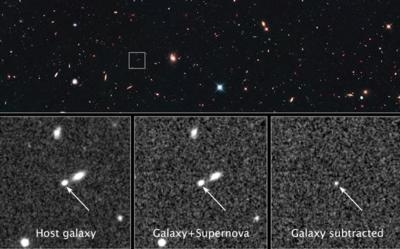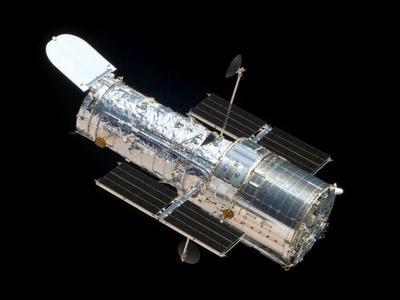Star Likely Exploded More Than 10 Billion Years Ago
NASA's Hubble Space Telescope has found the farthest supernova so far of the type used to measure cosmic distances. Supernova UDS10Wil, nicknamed SN Wilson after American President Woodrow Wilson, exploded more than 10 billion years ago. SN Wilson belongs to a special class called Type Ia supernovae. These bright beacons are prized by astronomers because they provide a consistent level of brightness that can be used to measure the expansion of space. They also yield clues to the nature of dark energy, the mysterious force accelerating the rate of expansion.

"This new distance record holder opens a window into the early universe, offering important new insights into how these stars explode," said David O. Jones of Johns Hopkins University in Baltimore, Md., an astronomer and lead author on the paper detailing the discovery. "We can test theories about how reliable these detonations are for understanding the evolution of the universe and its expansion."
The discovery was part of a three-year Hubble program, begun in 2010, to survey faraway Type Ia supernovae and determine whether they have changed during the 13.8 billion years since the explosive birth of the universe. Astronomers took advantage of the sharpness and versatility of Hubble's Wide Field Camera 3 to search for supernovae in near-infrared light and verify their distance with spectroscopy. Leading the work is Adam Riess of the Space Telescope Science Institute in Baltimore, MD, and Johns Hopkins University.
Finding remote supernovae provides a powerful method to measure the universe's accelerating expansion. So far, Riess's team has uncovered more than 100 supernovae of all types and distances, looking back in time from 2.4 billion years to more than 10 billion years. Of those new discoveries, the team has identified eight Type Ia supernovae, including SN Wilson, that exploded more than 9 billion years ago. "The Type Ia supernovae give us the most precise yardstick ever built, but we're not quite sure if it always measures exactly a yard," said team member Steve Rodney of Johns Hopkins University. "The more we understand these supernovae, the more precise our cosmic yardstick will become."

Although SN Wilson is only 4 percent more distant than the previous record holder, it pushes roughly 350 million years farther back in time. A separate team led by David Rubin of the U.S. Energy Department's Lawrence Berkeley National Laboratory in California announced the previous record just three months ago. Astronomers still have much to learn about the nature of dark energy and how Type Ia supernovae explode.
By finding Type Ia supernovae so early in the universe, astronomers can distinguish between two competing explosion models. In one model the explosion is caused by a merger between two white dwarfs. In another model, a white dwarf gradually feeds off its partner, a normal star, and explodes when it accretes too much mass. The team's preliminary evidence shows a sharp decline in the rate of Type Ia supernova blasts between roughly 7.5 billion years ago and more than 10 billion years ago. The steep drop-off favors the merger of two white dwarfs because it predicts that most stars in the early universe are too young to become Type Ia supernovae. "If supernovae were popcorn, the question is how long before they start popping?" Riess said. "You may have different theories about what is going on in the kernel. If you see when the first kernels popped and how often they popped, it tells you something important about the process of popping corn."
Knowing the type of trigger for Type Ia supernovae also will show how quickly the universe enriched itself with heavier elements such as iron. These exploding stars produce about half of the iron in the universe, the raw material for building planets, and life.
The team's results have been accepted for publication in an upcoming issue of The Astrophysical Journal.
(Image provided by NASA)
 ANN's Daily Aero-Linx (04.16.24)
ANN's Daily Aero-Linx (04.16.24) Aero-News: Quote of the Day (04.16.24)
Aero-News: Quote of the Day (04.16.24) Airborne 04.10.24: SnF24!, A50 Heritage Reveal, HeliCycle!, Montaer MC-01
Airborne 04.10.24: SnF24!, A50 Heritage Reveal, HeliCycle!, Montaer MC-01 Airborne 04.12.24: SnF24!, G100UL Is Here, Holy Micro, Plane Tags
Airborne 04.12.24: SnF24!, G100UL Is Here, Holy Micro, Plane Tags Airborne-Flight Training 04.17.24: Feds Need Controllers, Spirit Delay, Redbird
Airborne-Flight Training 04.17.24: Feds Need Controllers, Spirit Delay, Redbird




